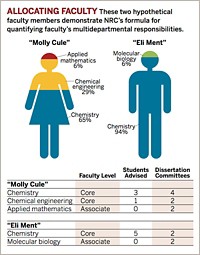Advertisement
Grab your lab coat. Let's get started
Welcome!
Welcome!
Create an account below to get 6 C&EN articles per month, receive newsletters and more - all free.
It seems this is your first time logging in online. Please enter the following information to continue.
As an ACS member you automatically get access to this site. All we need is few more details to create your reading experience.
Not you? Sign in with a different account.
Not you? Sign in with a different account.
ERROR 1
ERROR 1
ERROR 2
ERROR 2
ERROR 2
ERROR 2
ERROR 2
Password and Confirm password must match.
If you have an ACS member number, please enter it here so we can link this account to your membership. (optional)
ERROR 2
ACS values your privacy. By submitting your information, you are gaining access to C&EN and subscribing to our weekly newsletter. We use the information you provide to make your reading experience better, and we will never sell your data to third party members.
Education
Can NMR spectral interpretation be taught more efficiently?
Eye-tracking study identifies where students struggle, suggests ways to help them
by Celia Henry Arnaud
March 2, 2021
| A version of this story appeared in
Volume 99, Issue 8

It’s an open secret that organic chemistry students struggle to learn a skill that is integral to the field: interpreting nuclear magnetic resonance spectra. Organic chemists use this important tool to assess the purity of their starting materials and to verify their final products. Most students first encounter NMR in their undergraduate organic chemistry courses, but it usually takes research experience and lots of practice to become proficient.
Ginger V. Shultz, a chemistry professor at the University of Michigan, wants to understand where students are going astray in interpreting spectra—information that might guide instructors in helping students become proficient faster.
To understand where students go wrong, Shultz used eye tracking to capture how students interpret NMR spectra (J. Org. Chem. 2020, DOI: 10.1021/acs.joc.0c01398). An eye tracker monitors what areas of interest participants look at and how frequently their gaze moves back and forth between the areas. Shultz’s team compared undergraduates’ and graduate students’ approaches to gain insight into how students develop expertise in NMR.

Shultz and graduate student Megan Connor enlisted 18 undergraduates in second-semester organic chemistry and 7 first- or second-year doctoral students to interpret three NMR spectra. For each example, students were shown a molecule, a corresponding infrared spectrum, and IR and NMR reference tables, in addition to the NMR spectrum. They then had to decide whether the spectra and molecules matched. Immediately afterward, the students participated in retrospective think-aloud interviews in which they watched recordings of their eye movements and recollected their thought processes.
Through these interviews, the researchers found that students needed to understand five key areas to interpret the spectra correctly—basic principles, the effect of proton exchange on splitting (deviations from the N + 1 rule, which students learn as a way of predicting how many peaks they should see in the spectrum), acceptable variations in chemical shift, the effects of planes of symmetry, and the effects of experimental variables such as temperature. The researchers also observed that more advanced students used sophisticated assumptions and explanations with respect to those areas, suggesting that they had developed higher levels of expertise.
Differences in expertise were also reflected in the students’ eye movements. The undergraduates repeatedly looked at all the areas of interest and moved between them often. The doctoral students quickly focused on the regions that would tell them the spectra and molecules matched. “Expert problem solvers can quickly filter what information is useful and what information is not,” Shultz says. “This is showing that the undergraduates are not filtering what’s important.”
One problem involving an amide was particularly good at distinguishing participants’ levels of expertise. Amides are an example of a functional group that can violate the N + 1 rule.
“Amides behave in a really interesting way that is temperature dependent. And even a lot of graduate students, even if they’re more senior and had organic, wouldn’t necessarily know this particular phenomenon if they didn’t routinely work with molecules that had amide functional groups,” Shultz says.
Eye tracking has proved to be a useful tool in chemistry education, overcoming the shortcomings of other ways of studying how students solve problems.
“I like eye tracking because you can see what caught their attention, what was salient to them, what mattered, and what they did not notice,” says William Harwood, a chemist at the University of Northern Iowa who studies how chemists progress from novice to expert. Experts, who are already familiar with the material, “zoom in pretty quickly on key items.”
A strength of eye tracking is that it simultaneously provides qualitative and quantitative information. “What you’re looking at, where, how, when, in what order. Did you go from here to here, or did you do the other way round, or some other thing? That’s kind of qualitative,” Harwood says. “But it also gathers quantitative information. How many times did you look at this location? How long did you just sit and stare at that location? What caught your attention first?” And the recording acts as a prompt for students to narrate their thought processes.
Shultz isn’t the first to use eye-tracking technology to observe students working with NMR. In an earlier study, Joseph J. Topczewski, Norbert J. Pienta, and coworkers at the University of Iowa used eye tracking while organic chemistry students solved NMR problems (J. Chem. Educ. 2016, DOI: 10.1021/acs.jchemed.6b00528). Topczewski, who was a graduate student at the time, suggested that NMR spectral interpretation was a good match for eye tracking because interpreting NMR spectra is “one of the more visual tasks that organic chemists are forced to undergo.” That study was “a big toe in the water,” says Topczewski, now an assistant professor at the University of Minnesota Twin Cities. “It wasn’t very deep.” In contrast, he says, the methods in the new study are “leaps and bounds beyond anything that we did in the initial study.”
In Topczewski’s NMR study, students were given problems that looked more like classroom exercises. The problems included a single spectrum with four possible structures, including the correct one. Shultz’s study was designed to more closely mimic what organic chemists do in the lab. The researchers gave students three NMR spectra and for each one asked them a simple yes-no question: Does this spectrum match this compound?
Such a question reflects how organic chemists use NMR, says Valerie Schmidt, an organic chemist at the University of California San Diego. “You’ve set up a reaction with a particular transformation in mind with a small list of possible products or by-products you would expect to see in your spectrum,” she says. “You go into your spectral analysis already having a good idea of what you think should be there.”
Richard Mullins, an organic chemist at Xavier University and the author of a soon-to-be-published organic chemistry textbook, agrees. In the classroom, educators present NMR to students as if they will use it in isolation. “In the lab, you have other bits of information—for example, what you were trying to make.”
For Mullins, the goal of teaching NMR interpretation is to help students understand what NMR spectra represent. He describes the difference in perspectives of professors and new students interpreting spectra: “We see a signal, and we have this image of hydrogens and neighboring hydrogens. They see a signal, and it’s just lines on a page,” he says. The sophisticated, detailed methods used in the study “could be a game changer for the way we teach spectroscopy,” he says.
For students who do organic chemistry research, expertise in NMR is developed in the lab. That’s why Shultz targeted the Journal of Organic Chemistry rather than the Journal of Chemical Education. “We felt that there is a lot that is useful for people who teach graduate students via research labs. And so we wanted to reach that audience,” she says. The paper has been downloaded more than 1,500 times and was one of the journal’s most-read papers in January, according to the journal’s Twitter account.
Organic chemistry professors can already see ways to incorporate some of the findings in their classes and in their research groups. For Schmidt, the paper validated some things she already does, such as having students predict spectral properties and how they could distinguish between isomers.
But Schmidt also sees ways to improve her instruction. For example, instead of asking students to predict structures from context-free NMR spectra, she plans to further emphasize predicting spectra from structures and to couple spectral assignments with chemical reactions. “There are peaks that are diagnostic of certain things. And that’s what you want to try and learn,” she says. For a given reaction and product, “what are the things that are going to be unique about that compound? Those are the peaks you should be able to predict and know where to look. If they’re not there, it’s not the right compound.”
Shultz hopes that research mentors will recognize that beginning graduate students still have a lot to learn about NMR. She encourages organic chemists to consider practicing NMR interpretation during group meetings, much the way many of them already do mechanism problems. Schmidt and Topczewski already include NMR problems as part of group meetings, but they both say that more such problem-solving in a group setting could help students.
“It’s hard enough problem-solving on its own,” Shultz says. Without the right kind of support, students can flounder. “That probably feels quite stressful.”
Sign up for C&EN's must-read weekly newsletter





Join the conversation
Contact the reporter
Submit a Letter to the Editor for publication
Engage with us on Twitter